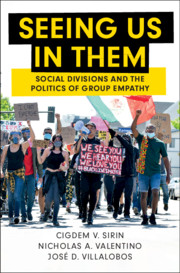Book contents
- Seeing Us in Them
- Cambridge Studies in Public Opinion and Political Psychology
- Seeing Us in Them
- Copyright page
- Dedication
- Contents
- Figures
- Tables
- Prologue
- 1 The Puzzle
- 2 Group Empathy Theory
- 3 Measuring Group Empathy
- 4 An Origin Story
- 5 Group Empathy and Homeland Security
- 6 Group Empathy and the Politics of Immigration
- 7 Group Empathy and Foreign Policy
- 8 Group Empathy in the Era of Trump
- 9 Group Empathy, Brexit, and Public Opinion in the United Kingdom
- 10 Cultivating Group Empathy and Challenging Ethnonationalist Politics
- Epilogue Group Empathy in Response to the COVID-19 Pandemic
- References
- Index
- Books in the series
8 - Group Empathy in the Era of Trump
Published online by Cambridge University Press: 11 March 2021
- Seeing Us in Them
- Cambridge Studies in Public Opinion and Political Psychology
- Seeing Us in Them
- Copyright page
- Dedication
- Contents
- Figures
- Tables
- Prologue
- 1 The Puzzle
- 2 Group Empathy Theory
- 3 Measuring Group Empathy
- 4 An Origin Story
- 5 Group Empathy and Homeland Security
- 6 Group Empathy and the Politics of Immigration
- 7 Group Empathy and Foreign Policy
- 8 Group Empathy in the Era of Trump
- 9 Group Empathy, Brexit, and Public Opinion in the United Kingdom
- 10 Cultivating Group Empathy and Challenging Ethnonationalist Politics
- Epilogue Group Empathy in Response to the COVID-19 Pandemic
- References
- Index
- Books in the series
Summary
Chapter 8 investigates the effects of group empathy on attitudes regarding a variety of policy changes that took place after Trump’s election. We examine how group empathy affects support for the Trump administration’s border wall and family separation policies, as well as its attempts to end the Obama-era DACA program. We also revisit Trump’s travel and immigration ban on several Muslim countries after he turned his controversial campaign promise into government policy via executive order. We further explore how group empathy influences opinions about some other group-related political issues such as hurricane relief for Puerto Rico, misappropriation of Native American names, symbols, and imagery in sports, as well as removal of Confederate statues and monuments. Finally, we examine the relationship between group empathy and support for contemporary social movements, namely Black Lives Matter, #MeToo, and LGBTQ rights. In all these tests, we find that group empathy is a powerful determinant of public reactions to the Trump administration’s policies above and beyond partisanship, ideology, and many other predispositions including racial resentment, even for issues concerning non-racial/ethnic marginalized outgroups.
Keywords
- Type
- Chapter
- Information
- Seeing Us in ThemSocial Divisions and the Politics of Group Empathy, pp. 166 - 211Publisher: Cambridge University PressPrint publication year: 2021

